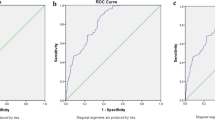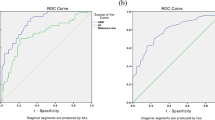Abstract
Background
To evaluate role of AMH as a diagnostic tool for PCOS.
Methods
This was a prospective case–control study on women attending Gynae OPD of Dr RML Hospital, New Delhi, from 1 November 2015 to 31 March 2017. Study comprised of 45 women with PCOS, diagnosed using Rotterdam criteria and 45 women as controls. Clinical history included oligomenorrhea, hirsutism, examination included BMI, Ferriman–Gallwey score, investigations included blood for FSH, LH, estradiol, TSH, prolactin, total testosterone, AMH level and pelvic USG which was done for all women.
Results
Both PCOS cases and control were matched for age and BMI. Median AMH levels of 4.32 ng/ml in PCOS cases was almost twice that of 2.32 ng/ml in controls (p = 0.001). Maximum diagnostic potential of AMH alone for PCOS was at a cut-off of 3.44 ng/ml with sensitivity of 77.78% and specificity of 68.89%. AMH was used as an adjunct to existing Rotterdam criteria as the fourth parameter OA+HA+PCOM+AMH (any three out of four) yielded sensitivity of 80%. However, when PCOM in Rotterdam criteria was replaced by AMH, OA+HA+AMH (any two out of three) or OA/HA+AMH resulted in sensitivity of 86.67 and 71.11%, respectively.
Conclusion
AMH levels were significantly higher in PCOS than in controls. AMH as an independent marker could not effectively diagnose PCOS. However, AMH levels as an adjunct to existing Rotterdam criteria for diagnosis of PCOS had good diagnostic potential.



Similar content being viewed by others
References
Begawy A, El-Mazny A, Abou-Salem N, et al. Anti-Müllerian hormone in polycystic ovary syndrome and normo-ovulatory women: correlation with clinical, hormonal and ultrasonographic parameters. Middle East Fertil Soc J. 2010;15(4):253–8.
Mahran A. The relationship between Anti-mullerian hormone and the clinical, biochemical and sonographic parameters in women with polycystic ovarian syndrome. Middle East Fertil Soc J. 2015;21(1):11–5.
Ramanand S, Ghongane B, Ramanand J, et al. Clinical characteristics of polycystic ovary syndrome in Indian women. Indian J Endocrinol Metab. 2013;17(1):138–45.
Broekmans F, de Ziegler D, Howles C, et al. The antral follicle count: practical recommendations for better standardization. Fertil Steril. 2010;94(3):1044–51.
Duijkers I, Klipping C. Polycystic ovaries, as defined by the 2003 Rotterdam consensus criteria, are found to be very common in young healthy women. Gynecol Endocrinol. 2010;26(3):152–60.
Johnstone E, Rosen M, Neril R, et al. The polycystic ovary post-rotterdam: a common, age-dependent finding in ovulatory women without metabolic significance. J Clin Endocrinol Metab. 2010;95(11):4965–72.
Kristensen S, Ramlau-Hansen C, Ernst E, et al. A very large proportion of young Danish women have polycystic ovaries: is a revision of the Rotterdam criteria needed? Hum Reprod. 2010;25(12):3117–22.
Streuli I, Fraisse T, Pillet C, et al. Serum antimüllerian hormone levels remain stable throughout the menstrual cycle and after oral or vaginal administration of synthetic sex steroids. Fertil Steril. 2008;90(2):395–400.
Sahmay S, Atakul N, Aydogan B, et al. Elevated serum levels of anti-Müllerian hormone can be introduced as a new diagnostic marker for polycystic ovary syndrome. Acta Obstetriciaet Gynecologica Scandinavica. 2013;92(12):1369–74.
Woo H, Kim K, Rhee E, et al. Differences of the association of anti-Mullerian hormone with clinical or biochemical characteristics between women with and without polycystic ovary syndrome. Endocr J. 2012;59(9):781–90.
Iliodromiti S, Kelsey T, Anderson R, et al. Can Anti-Müllerian hormone predict the diagnosis of polycystic ovary syndrome? A systematic review and meta-analysis of extracted data. J Clin Endocrinol Metab. 2013;98(8):3332–40.
Köninger A, Koch L, Edimiris P, et al. Anti-Mullerian hormone: an indicator for the severity of polycystic ovarian syndrome. Arch Gynecol Obstet. 2014;290(5):1023–30.
Wiweko B, Maidarti M, Priangga M, et al. Anti-mullerian hormone as a diagnostic and prognostic tool for PCOS patients. J Assist Reprod Genet. 2014;31(10):1311–6.
Homburg R, Ray A, Bhide P, et al. The relationship of serum anti-Mullerian hormone with polycystic ovarian morphology and polycystic ovary syndrome: a prospective cohort study. Hum Reprod. 2013;28(4):1077–83.
Ramezani Tehrani F, Solaymani-Dodaran M, Hedayati M, et al. Is polycystic ovary syndrome an exception for reproductive aging? Hum Reprod. 2010;25(7):1775–81.
Villarroel C, Merino P, Lopez P, et al. Polycystic ovarian morphology in adolescents with regular menstrual cycles is associated with elevated anti-Mullerian hormone. Hum Reprod. 2011;26(10):2861–8.
Lin Y, Chiu W, Wu C, et al. Antimüllerian hormone and polycystic ovary syndrome. Fertil Steril. 2011;96:230–5.
Tal R, Seifer D, Khanimov M, et al. Characterization of women with elevated antimüllerian hormone levels (AMH): correlation of AMH with polycystic ovarian syndrome phenotypes and assisted reproductive technology outcomes. Am J Obstet Gynecol. 2014;211(1):59.e1–8.
Cassar S, Teede H, Moran L, et al. Polycystic Ovary Syndrome and Anti-Müllerian hormone: role of insulin resistance, androgens, obesity and gonadotropins. Clin Endocrinol. 2014;81(6):899–906.
Sopher A, Grigoriev G, Laura D, et al. Anti-Mullerian hormone may be a useful adjunct in the diagnosis of polycystic ovary syndrome in nonobese adolescents. J Pediatr Endocrinol Metab. 2014;27:1175–9.
Tayrab E, Ali M, Modawe G, et al. Serum Anti-Müllerian hormone as laboratory predictor in infertile women with and without polycystic ovary syndrome. Am J Res Com. 2014;2(3):61–6.
Saikumar P, KalaiSelvi V, Prabhu K, et al. Anti Mullerian hormone: a potential marker for recruited non growing follicle of ovarian pool in women with polycystic ovarian syndrome. J Clin Diagn Res. 2013;7(9):1866–9.
Chao K, Ho C, Shyong W, et al. Anti-Mullerian hormone serum level as a predictive marker of ovarian function in Taiwanese women. J Chin Med Assoc. 2012;75(2):70–4.
Dewailly D, Gronier H, Poncelet E, et al. Diagnosis of polycystic ovary syndrome (PCOS): revisiting the threshold values of follicle count on ultrasound and of the serum AMH level for the definition of polycystic ovaries. Hum Reprod. 2011;26(11):3123–9.
Li Y, Ma Y, Chen X, et al. Different diagnostic power of anti-Mullerian hormone in evaluating women with polycystic ovaries with and without hyperandrogenism. J Assist Reprod Genet. 2012;29(10):1147–51.
Cengiz H, Ekin M, Dagdeviren H, et al. Comparison of serum anti-Müllerian hormone levels in normal weight and overweight–obese adolescent patients with polycystic ovary syndrome. Eur J Obstet Gynecol Reprod Biol. 2014;180:46–50.
Hart R, Doherty D, Norman R, et al. Serum antimullerian hormone (AMH) levels are elevated in adolescent girls with polycystic ovaries and the polycystic ovarian syndrome (PCOS). Fertil Steril. 2010;94(3):1118–21.
Sahmay S, Aydin Y, Oncul M, et al. Diagnosis of polycystic ovary syndrome: AMH in combination with clinical symptoms. J Assist Reprod Genet. 2014;31(2):213–20.
Eilertsen T, Vanky E, Carlsen S. Anti-Mullerian hormone in the diagnosis of polycystic ovary syndrome: Can morphologic description be replaced? Hum Reprod. 2012;27(8):2494–502.
Acknowledgement
We thank all the patients who consented to participate in this study.
Author information
Authors and Affiliations
Corresponding author
Ethics declarations
Conflict of interest
All the authors declare that they have no relevant conflict of interest.
Ethical Approval
The study was approved by Medical Ethical committee of PGIMER & DR RML Hospital, New Delhi.
Informed Consent
Informed consent was taken from all the patients who agreed to participate in the study.
Additional information
Upma Saxena, Professor and Senior Gynaecologist in the Department of Obstetrics and Gynaecology, PGIMER and Dr RML Hospital, New Delhi; Manisha Ramani, postgraduate student in the Department of Obstetrics and Gynaecology, PGIMER and Dr RML Hospital, New Delhi; Pushpa Singh, Professor and Consultant in the Department of Obstetrics and Gynaecology, PGIMER and Dr RML Hospital, New Delhi.
Rights and permissions
About this article
Cite this article
Saxena, U., Ramani, M. & Singh, P. Role of AMH as Diagnostic Tool for Polycystic Ovarian Syndrome. J Obstet Gynecol India 68, 117–122 (2018). https://doi.org/10.1007/s13224-017-1066-4
Received:
Accepted:
Published:
Issue Date:
DOI: https://doi.org/10.1007/s13224-017-1066-4




